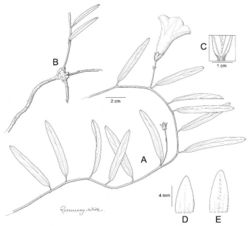Ipomoea ensiformis
| Notice: | This page is derived from the original publication listed below, whose author(s) should always be credited. Further contributors may edit and improve the content of this page and, consequently, need to be credited as well (see page history). Any assessment of factual correctness requires a careful review of the original article as well as of subsequent contributions.
If you are uncertain whether your planned contribution is correct or not, we suggest that you use the associated discussion page instead of editing the page directly. This page should be cited as follows (rationale):
Citation formats to copy and paste
BibTeX: @article{Wood2017PhytoKeys, RIS/ Endnote: TY - JOUR Wikipedia/ Citizendium: <ref name="Wood2017PhytoKeys">{{Citation See also the citation download page at the journal. |
Ordo: Solanales
Familia: Convolvulaceae
Genus: Ipomoea
Name
Ipomoea ensiformis J.R.I.Wood & Scotland sp.nov. – Wikispecies link – Pensoft Profile
Diagnosis
Ipomoea ensiformis somewhat resembling I. campestris but differs in a range of characters. It is a prostrate, glabrescent (pubescent only on young parts) plant, the leaves distinctly petiolate and terminating in an obtuse apex. The sepals are glabrous, < 8 mm long and the corolla is smaller at 3–4 cm long and relatively widely funnel-shaped. In contrast, I. campestris is usually erect, pubescent to pilose in all vegetative parts and the leaves are subsessile, acute and mucronate. The sepals are 8–11 mm long, the exterior pubescent while the corolla is about 5.5 to 6 cm in length. Table 1.
Type
Brazil, Goias, 5 km Alto Paraiso, Chapada dos Veadeiros, 1450 m, 24 Jan 1979, Gates & Estabrook 4 (holotype UB62303, isotypes MICH, RB00263006).
Description
Procumbent perennial herb, stems thinly pubescent, to 50 cm; rootstock a knotted woody xylopodium. Leaves shortly petiolate, 2–6 × 0.3–1.2 cm, oblong to oblong-lanceolate, base rounded, apex subacute to obtuse, very shortly mucronate, margin entire to undulate, glabrescent, the very young leaves pubescent; petioles 1–4 mm, puberulent. Inflorescence of solitary (rarely paired), axillary flowers borne on slender peduncles; peduncles 1.4–3.2 cm, slender, puberulent; bracteoles 3 × 1 mm, ovate, acuminate, relatively persistent; pedicels 5–6 mm, thinly puberulent; sepals subequal, outer 6–7 × 2.5–3 mm, oblong-ovate, obtuse, glabrous, inner similar but narrowly oblong-ovate, 7–8 mm long, abaxial surface sparsely pubescent centrally; corolla 3–4 cm, pink, very sparsely pubescent on midpetaline bands, funnel-shaped, limb 3.5 cm diameter. Capsule and seeds not seen.
Distribution and habitat
BRAZIL. Endemic to Goiás State where it is only known from the type collection. It is one of several Ipomoea species which are apparently restricted to the Chapada dos Veadeiros and, like I. graminifolia, was found at 1450 m, an exceptionally high altitude in the Brazilian planalto. Figure 9.
Conservation status
In the absence of other collections or any information about its frequency, the status of this species can only be classified as Data Deficient (DD) within IUCN (2012)[1] guidelines. It would be treated as a “black star” species within the classification of Hawthorne and Marshall (2016)[2], but again this must be considered as a provisional classification as no systematic search has been made for the species at the type locality or in other similar habitats in the area.
Etymology
The epithet ensiformis refers to the shape of the leaves, which resemble small swords.
Notes
This has the appearance of a nearly glabrous prostrate form of Ipomoea campestris. I. campestris is quite variable in leaf shape but is always readily distinguished by the longer, narrower corolla, which reaches 6 cm, and the conspicuous pubescent indumentum.
Taxon Treatment
- Wood, J; Muñoz-Rodríguez, P; Degen, R; Scotland, R; 2017: New species of Ipomoea (Convolvulaceae) from South America PhytoKeys, (88): 1-38. doi
Images
|
Other References
- ↑ IUCN (2012) IUCN Red List Categories and Criteria. Ed 2. International Union for the Conservation of Nature, Gland, Switzerland. http://s3.amazonaws.com/iucnredlist-newcms/staging/public/attachments/3097/redlist_cats_crit_en.pdf
- ↑ Hawthorne W, Marshall C (2016) A Manual for Rapid Botanical Survey (RBS) and measurement of vegetation bioquality. Published online, June 2016. Department of Plant Sciences, University of Oxford, U.K. http://herbaria-old.plants.ox.ac.uk/rbs/

